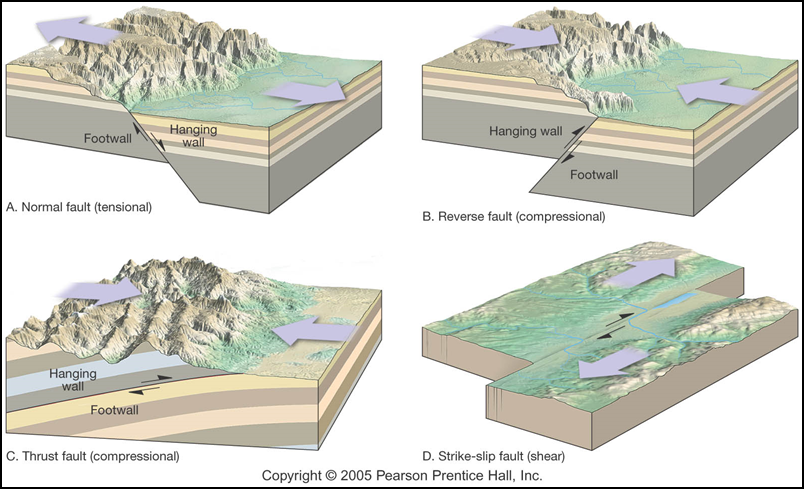



Fold axes parallel the long axis of the strain ellipse – the axis of maximum extension, and bisect the angle between Riedel and conjugate Riedel shears. Conjugate faults occur in dip-slip and strike-slip structural domains.Įn echelon folds: Anticline-syncline pairs that in an ideal system will be about 45 o to the PDZ. Riedel shears.Ĭonjugate Riedel shears: See Riedel shears.Ĭonjugate faults: Fault pairs where the fault planes intersect at (commonly) 60 o such that the direction of minimum extension bisects this angle, and the direction of maximum extension bisects the obtuse angle (~120 o). Antithetic and synthetic faults commonly occur in parallel arrays. Opposing subsidiary structures are synthetic where the displacement has the same shear sense as the master fault. They occur in extensional regimes (such as accommodation in the hanging wall of listric faults), compressional regimes as back-thrusts, and strike-slip faults. An idealized array modified from Biddle and Christie-Blick, 1985, Fig.3.Īntithetic faults: Subsidiary or minor faults that have a sense of displacement opposite that of a master fault or principal deformation zone. Some of the more common structures associated with strike-slip faults. There is a companion post of Basins formed by strike-slip tectonics You are invited to look at two other posts on faults – Thrust faults, and more general Terminology of faults.
RIGHT LATERAL STRIKE SLIP FAULT PDF
Most have been borrowed and modified from important papers and texts on the subject: Biddle and Christie-Blick, 1985 (Intro to SEPM volume – PDF available) Sylvester, 1988 – (PDF) Nilsen and Sylvester, 1999 (PDF) Davis and Reynolds, 1996 (an excellent text) Allen and Allen, 2005, 2013. In fact, it is these “minor” structures that frequently allow us to decipher the tectonic and kinematic history of such faults.Ĭommon strike-slip structures are illustrated in the following diagrams and definitions. Strike-slip faults do not occur in isolation they come with a bevy of subsidiary structures that reflect the associated extensional and contractional stresses. Our understanding of strike-slip faults has advanced with detailed field mapping, subsurface imaging, and numerical and analogue modelling. Convergent margins with oblique plate trajectories will also generate strike-slip faults in accretionary prisms, forearcs and backarcs. The characteristic zig zag dismembering of mid-ocean spreading ridges is caused by ridge transforms that accommodate the strain from oblique spreading. They form in oceanic and continental crust/lithosphere. Strike-slip faults occur in most plate tectonic settings, primarily at plate boundaries (like most other fault types). The present trajectory along Alpine Fault is also transpressional. Pacific plate trajectories at Hikurangi margin become increasingly oblique from north to south. The right-lateral Alpine Fault transform and its strike-slip fault splays (Marlborough fault system), in the context of other plate tectonic elements: the Hikurangi subduction zone that is linked to Alpine Fault via Hope Fault and the subduction zone at the south end of South Island where oceanic crust of the Australian Plate is subducting beneath the Pacific plate (opposite polarity to Hikurangi). But he was right… Jumping ahead a few years (and encapsulating several decades of science history in a single sentence), we now know this fault as the Alpine Fault, a dextral, or right-lateral transform strike-slip fault that also doubles as the boundary between the Pacific and Australian plates. Wellman’s hypothesis turned a few heads and invited its share of derision. The consensus at the time was that crustal movements were dominated by vertical displacements. The dislocation was the result of 600 km lateral shift along a major fault. In 1940 Harold Wellman and Dick Willett proposed that two groups of rocks at either end of the South Island of New Zealand, each having the same stratigraphic and lithologic characteristics, were at one time a single unit. The fault splays are clearly delineated by valleys. The intersection of splay faults that trend northeast indicated by black dots. The master fault is a prominent linear feature immediately left of the snow line (black arrow, bottom). An oblique view of Alpine Fault from the International Space Station.


 0 kommentar(er)
0 kommentar(er)
